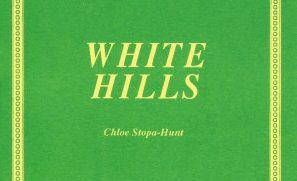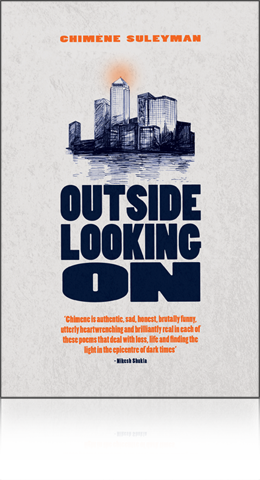White Hills by Chloe Stopa-Hunt
– Reviewed by Charles Whalley –
In White Hills, Chloe Stopa-Hunt writes with strange grandeur and evident faith in a special provenance and purpose for poetry. Whilst many contemporary poets gain much from having a coke with Frank O’Hara, White Hills recalls things pressed and dried between the pages of books, rather than the life we muddle off into once the library is closed. These poems are fiercely, precisely compressed into small, bright glimpses, so single-mindedly pursuing their detachment that they are at times breathtaking, to the extent that I need a break after reading them.
Much of the pamphlet’s strength lies in mood and tone. White Hills exudes a louche, doomed, fin de siècle luxury. Flicking through the seventeen poems gives: linnet, orange, pince-nez, tulips, damselfly, champagne, ivory, lemon rind, silk, marble, candlelight, madrigals, dry primrose, wheat, chemise, exquisite. It’s very particular in its desired field of connotations, though this can make it seem limited in grasp. Edible plants or flowers spring up from almost every page, becoming overpowering across the whole, like a soap shop. When, in ‘The Gentleman’, pails in a dairy are “full of cowslips” (the flower, I think, on the pamphlet’s cover), I’ve begun to feel like I’d be surprised if they contained anything else.
Many of the poems, with a brevity that precludes much narrative movement, resemble paintings, either in a preference for visual images or for a visual logic that associates them. ‘Education’, for instance, ends on its second stanza:
A rain begins,
Of red
Morning flowers
And fresh,
Sufficient light.
As I read, it seems to come together by visual implication rather than description. But although the impact would seem to be in the spectacular and stark — its rain of red flowers and light — the workings and the beauty of the lines are as much in the sound as in its dreamy, gentle surrealism. Here I have the intertwining roll of R and Fs, and the near rhyme of “begin” and “morning”, and the ending with the sh in “fresh” and in ‘fish’ in “sufficient”. Stopa-Hunt’s technical abilities are continually rewarding, in that the rhythm and consonance and overall poise of her poems would be enough to keep thinking on for much longer than this review, all else besides.
At its best, the pamphlet keeps to these brief, bright glimpses into new worlds, suggesting and evoking myth or folklore, with a depth stretching far beyond the poem. ‘Drowned Boys’ or ‘The Leopard-God’ are particularly strong in this regard, in that they seem to be pulling me into dialogue with some greater, obscure story. In the longer poems, this approach, with its suggestion of hidden meaning, begins to feel like allegory. The eponymous poem ‘White Hills’ is an example of this, beginning:
Across the white hills the dying walk,
In their ivory shoes, with hands full of bracken –
Pathless, trackless, but steady-eyed. Friendly,
If you meet them by chance.
This poem is probably the weakest, as the hint of allegory comes with a suspicion that the oneiric, unconscious meaning is now deliberate and directed, that I am being told rather than shown. But these are all variations on how poetry can express more than it seems, and Stopa-Hunt’s poems feel literary whilst conveying something present and keenly, if obliquely, felt.
To come back to ‘Education’, the first stanza suggests something of White Hills’ poetics:
The lesson is:
Setting your
Night-burnt cheek
To the marble
Lion’s head.
With all the painterly drama of the rest of the book, at first this seems to suggest that unmediated sensation is a form of knowledge, without need for explanation: the coolness of marble on hot skin is the “lesson”. But, beyond this, it suggests the lesson is reading about feeling the coolness of marble on hot skin, taking up the direct address of “your” to imagine a sensation, to create a whole moment with that visceral point at its heart. The cheek is not just hot but “night-burnt”; the cool marble is a “lion’s head”. The sensible quality that burns through the poetry extends into the words, through the verbal art of the whole poem. This is precisely how Stopa-Hunt’s writing becomes so vivid as to be unsettling, in that it communicates on multiple levels at once and suggests so much, in poems often no longer than forty words. White Hills is replete with references to classical literature, myth and folklore; but the real literariness of the pamphlet, the quality that makes it so enthralling, is its awareness of expressive capacities and its deployment of them to such effect.
It’s rare to have a poet of such dazzling accomplishment in a quiet little pamphlet like this, although it wouldn’t be fair to describe Stopa-Hunt as entirely unknown, having won an Eric Gregory Award a few years ago and with a record of publications in magazines for a few years. Alongside an impressive pamphlet from Edwina Attlee, Clinic have produced a pamphlet that deserves a lot of attention. Like any good and idiosyncratic style, I suspect that Stopa-Hunt’s would be easy to parody. I have some reservations about the sepia tones too, in that I don’t ultimately think it’s the purpose or future of poetry to look inwards and backwards, as White Hills does so deliberately. But the grandeur mentioned at the start of this review is achieved with such force and conviction that it’s impossible not to be carried along by it, not to be utterly convinced.




